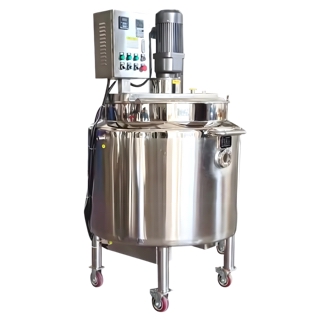Mixing tank
A mixing tank is an industrial vessel designed to homogenize, blend, or agitate liquids, semi-solids, or solids-liquid mixtures. Constructed from materials like stainless steel (SS304/SS316), polyethylene, or glass-lined steel, it is integral to industries such as chemicals, pharmaceuticals, food and beverage, and wastewater treatment. Tanks vary in size (50L to 20,000L+) and configuration (top/bottom-mounted agitators, baffles) to accommodate viscosity, temperature, and process requirements.

Material Compatibility: Corrosion-resistant construction for aggressive chemicals or sanitary applications (e.g., Food-grade stainless steel).
Agitation System: Adjustable-speed motors (0.5–100 HP), impeller types (propeller, turbine, anchor), and shaft seals (mechanical, lip).
Design: Cylindrical shape with conical/dished bottoms for complete drainage; optional jacketed walls for heating/cooling.
Controls: Automated program systems for RPM, temperature, and batch timing.
Safety: Pressure relief valves, sight glasses, and CIP (Clean-in-Place) compatibility.
Technical specification
| Model | Volume(L) | Voltage | Tank diameter(mm) | Speed (r/min) |
|---|---|---|---|---|
| MT-15 | 15 | 220V/380V | 200 | 35/100/1440/2900 |
| MT-30 | 30 | 220V/380V | 300 | 35/100/1440/2900 |
| MT-50 | 50 | 220V/380V | 400 | 35/100/1440/2900 |
| MT-100 | 100 | 380V | 500 | 35/100/1440/2900 |
| MT-200 | 200 | 380V | 600 | 35/100/1440/2900 |
| MT-300 | 300 | 380V | 700 | 35/100/1440/2900 |
| MT-500 | 500 | 380V | 800 | 35/100/1440/2900 |
| MT-800 | 800 | 380V | 900 | 35/100/1440/2900 |
| MT-1000 | 1000 | 380V | 1100 | 35/100/1440/2900 |
| MT-1500 | 1500 | 380V | 1200 | 35/100/1440/2900 |
| MT-2000 | 2000 | 380V | 1200 | 35/100/1440/2900 |
Video
Buying advice
Key considerations for evaluating industrial mixing tanks include material compatibility, impeller design, motor power alignment with fluid dynamics, and certifications for industry-specific compliance. Criteria prioritize corrosion resistance, surface finish quality, and validated flow patterns to eliminate dead zones.
Capacity
Select based on batch volume (include 10–20% headspace for frothing).
Material
Choose stainless steel for hygiene-critical applications (e.g., food/pharma); polyethylene for corrosive chemicals.
Agitation Needs
High-viscosity fluids require high-torque motors and anchor impellers.
Maintenance
Standardized procedures for ensuring system reliability cover mechanical seal inspections, impeller wear monitoring, weld integrity testing, and thermal jacket maintenance. Protocols emphasize documentation rigor, spare part specifications, and adherence to regulatory audit trails.
Daily: Inspect seals/lubrication; clean surfaces with compatible solvents.
Monthly: Check motor alignment, belt tension, and impeller integrity.
Annually: Replace worn bearings/seals; pressure-test jacketed systems.
Post-Use: Drain fully to prevent residue buildup; sanitize per SOPs for sterile processes.
COMMON ISSUES & SOLUTIONS
| Issue | Cause | Solution |
|---|---|---|
| Leakage | Worn seals/gasket degradation | Replace seals; torque bolts evenly. |
| Poor Mixing | Incorrect impeller speed/type | Adjust RPM; switch to radial-flow impeller. |
| Motor Overheating | Overloading or misalignment | Reduce load; realign motor/agitator shaft. |
| Temperature Deviation | Jacket blockage/control failure | Flush jacket; recalibrate thermostat. |
| Vibration/Noise | Unbalanced impeller or bearing wear | Rebalance impeller; lubricate/replace bearings. |